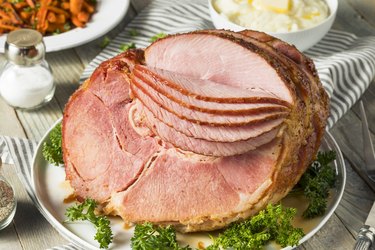
Ham is a type of processed pork that comes from the leg of a pig. All ham is processed in order to preserve it and enhance its flavors, but the way a ham is preserved varies. Hams come in literally hundreds of preparations, shapes and sizes, but one way to categorize ham is by two main varieties: city ham and country ham.
What Is City Ham?
Video of the Day
City ham is the most common and popular type of ham, and as such, it's usually referred to simply as "ham." City ham is most often wet-cured, which means it has been injected with a brine of sugar and seasonings. Sold fully cooked, city ham only needs to be warmed up before it is eaten (though you can certainly also eat it cold), although many people apply a simple sugar or honey glaze before putting it in the oven.
Video of the Day
City ham is sold both bone-in and boneless. The bone-in varieties generally have more flavor but can be more difficult to slice.
How to Eat City Ham
City ham is most traditionally served as the centerpiece of a dinner, especially on a weekend or holiday. However, slices of ham can also be served in sandwiches, at breakfast, in soup or with beans. Basically, most of the times you've eaten ham in the past, it has been city ham unless otherwise stated.
What Is Country Ham?
Country ham is significantly less common than city ham and is mostly popular through the Southern states of the United States. Country hams are dry-cured, which means that they are rubbed with spices and then aged for several months or even years before they're sold and eaten. They are often smoked after curing and can be bought either cooked or uncooked. More often than not, country ham is prepared and sold bone-in.
How to Eat Country Ham
Because of its saltiness, country ham is not often served in large portions or in traditional ham feasts like Easter or Christmas. Instead, it's most commonly heated by the slice in a skillet and served as part of a breakfast along with eggs and potatoes and with a side of gravy or else inside of a biscuit. Country ham might also be diced and served in casseroles and salads, where it can add a burst of salty flavor.
Some soak country hams in several changes of water before preparing it in order to reduce the salt content, but others eat it as is. Some also scrape off the outer crusts of country ham to lower sodium content, while others leave it on.
Like city hams, country hams can be glazed before they're warmed or cooked. Southerners often prefer a bourbon and molasses glaze or a glaze made from an orange juice reduction.
What's the Difference Between City Ham and Country Ham?
Most basically, city hams are wet-cured, and country hams are dry-cured. Country hams are older, drier and saltier, while city hams have a milder, juicier consistency. If you've never had country ham, you might be surprised by its saltiness and flavor, and you may be unfamiliar with how it is best cooked and served.
How Much Ham Should I Buy?
If ham will be your main course, you will need different amounts depending on the type and preparation of the ham. For example, you will need a heavier bone-in ham since the bones add weight. You will need to buy less country ham since the meat is so salty and rich that the portions are smaller.
- If you are buying a bone-in city ham, allow 8 to 10 ounces of ham per person.
- If you are buying a boneless city ham, allow 6 to 8 ounces per person.
- If you are buying a boneless country ham, allow 6 to 8 ounces per person.
- If you are buying a bone-in country ham, allow 4 to 6 ounces per person.